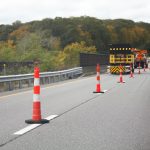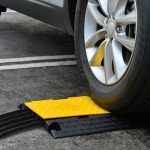Introduction
Definition of Speed Bumps
A speed bump is a traffic calming device that is typically installed on residential streets or parking lots to slow down vehicles. It is a raised portion of the road that forces drivers to reduce their speed as they drive over it. Speed bumps are usually made of asphalt or concrete and are designed to be highly visible to drivers. They are effective in reducing vehicle speed and promoting safety in areas where speeding is a concern.
Definition of Speed Humps
A speed hump is a traffic calming device that is used to slow down vehicles in residential areas, parking lots, and other areas where speed needs to be controlled. Unlike speed bumps, which are typically higher and more abrupt, speed humps are longer and have a gradual incline and decline. This design allows vehicles to pass over them at a higher speed without causing discomfort or damage to the vehicle. The purpose of speed humps is to encourage drivers to reduce their speed and increase safety for pedestrians and other road users.
Purpose of the Article
The purpose of this article is to provide a clear understanding of the difference between Speed bumps & Humps. Many people often confuse these two traffic calming devices, but they serve different purposes and have distinct characteristics. By explaining the purpose and design of each, this article aims to educate readers on when and where each should be used, as well as their impact on traffic flow and safety. Understanding the difference between speed bumps and speed humps is crucial for effective traffic management and ensuring the safety of drivers, pedestrians, and cyclists.
Design
Physical Characteristics of Speed Bumps
Speed bumps are physical traffic calming measures that are typically installed on roads to slow down vehicles. They are characterized by their raised profile, which creates a noticeable change in the road surface. Speed bumps are usually made of durable materials such as concrete or asphalt, and they are designed to withstand the weight and impact of vehicles. These traffic calming devices are typically wider than speed humps and have a steeper incline, resulting in a more abrupt change in vehicle speed. The purpose of speed bumps is to force drivers to reduce their speed significantly, promoting safer driving conditions and preventing accidents.
Physical Characteristics of Speed Humps
Speed humps are traffic calming devices that are designed to reduce vehicle speeds in residential areas and other areas with low-speed limits. They are typically made of asphalt or concrete and have a rounded shape. The height of speed humps can vary, but they are generally between 3 to 4 inches tall. The width of speed humps is typically between 10 to 14 feet. These physical characteristics of speed humps help to slow down vehicles by causing drivers to reduce their speed as they pass over the hump. Unlike speed bumps, which are more abrupt and jarring, speed humps provide a more gradual and smoother transition for vehicles, making them a preferred option for controlling speed in certain areas.
Installation Requirements
When it comes to the installation requirements of speed bumps and speed humps, there are a few key factors to consider. Firstly, both speed bumps and speed humps need to be installed in accordance with local regulations and guidelines. This ensures that they are placed at the appropriate locations and heights to effectively slow down vehicles. Additionally, the installation process may require certain tools and equipment, such as asphalt or concrete for the base, and proper signage to alert drivers. It is important to hire experienced professionals who are knowledgeable about the installation process to ensure that the speed bumps and speed humps are installed correctly and safely.
Functionality
Effect on Vehicle Speed
The Effect on Vehicle Speed is an important aspect to consider when comparing speed bumps and speed humps. Speed bumps are designed to significantly reduce vehicle speed by creating a sudden jolt or bump when a vehicle drives over them. This abrupt change in speed helps to ensure that drivers slow down and adhere to the designated speed limit. On the other hand, speed humps are designed to gently slow down vehicles by gradually raising and lowering the suspension. While speed humps still effectively reduce vehicle speed, they provide a smoother ride compared to speed bumps. Ultimately, the choice between speed bumps and speed humps depends on the desired level of speed reduction and the impact on vehicle comfort.
Effect on Traffic Flow
The effect of speed bumps and speed humps on traffic flow is a topic of great importance in transportation planning. Speed bumps, also known as speed breakers, are designed to slow down vehicles by creating a sudden change in elevation. They are typically found in residential areas or parking lots and are effective at reducing vehicle speeds. However, speed bumps can also cause delays and disruptions in traffic flow, especially if drivers are not prepared for them. On the other hand, speed humps are more gradual in shape and are designed to encourage drivers to slow down without causing abrupt changes in speed. They are often used on roads with higher speed limits and can help maintain a smoother traffic flow. While both speed bumps and speed humps serve the purpose of slowing down vehicles, their impact on traffic flow should be carefully considered when implementing them in different road environments.
Safety Considerations
When it comes to safety considerations, both speed bumps and speed humps play a crucial role. These traffic calming devices are designed to reduce vehicle speeds in specific areas, promoting safer driving conditions for pedestrians, cyclists, and motorists alike. By forcing drivers to slow down, speed bumps and speed humps help prevent accidents and minimize the severity of any potential collisions. Additionally, they can enhance visibility and awareness, particularly in areas with high foot traffic or near schools and residential neighborhoods. Overall, the installation of speed bumps and speed humps serves as an effective measure in prioritizing safety on the roads.
Advantages
Reduced Vehicle Speed
Reduced vehicle speed is one of the primary benefits of both speed bumps and speed humps. These traffic calming measures are designed to slow down vehicles and promote safer driving in residential areas, school zones, and other areas with high pedestrian activity. By forcing drivers to reduce their speed, speed bumps and speed humps help prevent accidents and create a more secure environment for pedestrians and cyclists. Additionally, the reduced speed also helps to minimize noise and vibrations caused by vehicles, contributing to a quieter and more peaceful neighborhood.
Improved Pedestrian Safety
Improved pedestrian safety is one of the key benefits of implementing speed bumps and speed humps. These traffic calming measures are designed to slow down vehicles, making the roads safer for pedestrians. By forcing drivers to reduce their speed, speed bumps and speed humps create a safer environment for pedestrians to cross the road or walk alongside it. This increased safety is especially important in areas with high foot traffic, such as school zones, residential neighborhoods, and shopping centers. By effectively reducing vehicle speeds, speed bumps and speed humps contribute to the overall goal of improving pedestrian safety and reducing the risk of accidents and injuries.
Traffic Calming Benefits
Traffic calming measures, such as speed bumps and speed humps, offer numerous benefits in improving road safety and reducing vehicle speeds. These measures are designed to slow down traffic, creating a safer environment for pedestrians and cyclists. By forcing drivers to reduce their speed, speed bumps and speed humps help prevent accidents and minimize the severity of any collisions that may occur. Additionally, these traffic calming devices can enhance the overall livability of a neighborhood by discouraging excessive speeding and promoting a more peaceful and tranquil atmosphere. Overall, the implementation of speed bumps and speed humps as part of traffic calming strategies can significantly contribute to creating safer and more enjoyable roadways for everyone.
Disadvantages
Discomfort for Vehicle Occupants
Speed bumps and speed humps are both traffic calming measures used to slow down vehicles in residential areas, parking lots, and other areas with low speed limits. However, there is a significant difference in the level of discomfort they cause for vehicle occupants. While speed bumps are typically higher and more abrupt, causing a jolt and discomfort to the occupants, speed humps are longer and have a gentler slope, resulting in a smoother ride. The aim of speed bumps is to force drivers to slow down significantly, while speed humps are designed to encourage drivers to reduce their speed gradually. Therefore, speed bumps are more effective at slowing down vehicles but can be more uncomfortable for occupants, while speed humps provide a more comfortable ride but may not slow down vehicles as effectively.
Potential Damage to Vehicles
One potential concern with both speed bumps and speed humps is the potential damage they can cause to vehicles. Speed bumps, which are typically higher and more abrupt, can pose a greater risk of damage to vehicles, especially if they are driven over at high speeds. The abrupt jolt can cause suspension damage, alignment issues, and even damage to the undercarriage of the vehicle. On the other hand, speed humps are designed to be less abrupt and have a gentler slope, reducing the risk of damage to vehicles. However, if drivers approach speed humps at high speeds, there is still a possibility of damage, although the risk is generally lower compared to speed bumps. It is important for drivers to be aware of these potential risks and adjust their speed accordingly when encountering speed bumps or speed humps.
Emergency Vehicle Access
Emergency vehicle access is a crucial consideration when it comes to the installation of speed bumps and speed humps. These traffic calming measures are designed to slow down vehicles and improve safety in residential areas. However, it is important to ensure that emergency vehicles can still navigate through these obstacles without any delay or difficulty. To achieve this, speed humps are typically preferred over speed bumps. Speed humps are wider and have a more gradual incline, allowing emergency vehicles to pass over them at a controlled speed. This ensures that emergency response times are not compromised, and that help can reach those in need quickly and efficiently.
Conclusion
Summary of Key Points
The key points discussed in this article highlight the difference between speed bumps and speed humps. Speed bumps are typically higher and have a sharper incline compared to speed humps, which are longer and have a gradual incline. Speed bumps are often used in areas where a significant reduction in speed is required, such as near schools or pedestrian crossings. On the other hand, speed humps are designed to encourage drivers to slow down without causing a jolt to the vehicle. They are commonly used in residential areas or parking lots. Understanding the distinction between speed bumps and speed humps is crucial for implementing appropriate traffic calming measures and ensuring road safety.
Considerations for Implementation
When implementing speed bumps or speed humps, there are several considerations to keep in mind. Firstly, it is important to assess the traffic volume and speed in the area where the traffic calming measure will be installed. This will help determine the appropriate height and spacing of the bumps or humps. Additionally, the placement of these traffic calming devices should be strategically planned to ensure maximum effectiveness. It is also crucial to consider the impact on emergency vehicles and public transportation routes. Proper signage and markings should be used to alert drivers of the presence of speed bumps or humps. Finally, regular maintenance and monitoring should be conducted to ensure that the traffic calming measures are functioning properly and not causing any unintended negative effects.
Future Developments
In terms of future developments, there are several possibilities that can be explored to enhance the effectiveness of both speed bumps and speed humps. One potential avenue is the use of advanced materials that can withstand heavy traffic and extreme weather conditions, ensuring their durability and longevity. Additionally, incorporating technology such as sensors and cameras into these traffic calming devices can provide valuable data on vehicle speed and traffic patterns, allowing for more informed decision-making in traffic management. Furthermore, the integration of renewable energy sources, such as solar panels, into speed bumps and speed humps can contribute to sustainability efforts by generating electricity to power nearby streetlights or other infrastructure. Overall, the future of speed bumps and speed humps holds great potential for innovation and improvement, promising safer and more efficient roadways for all.






